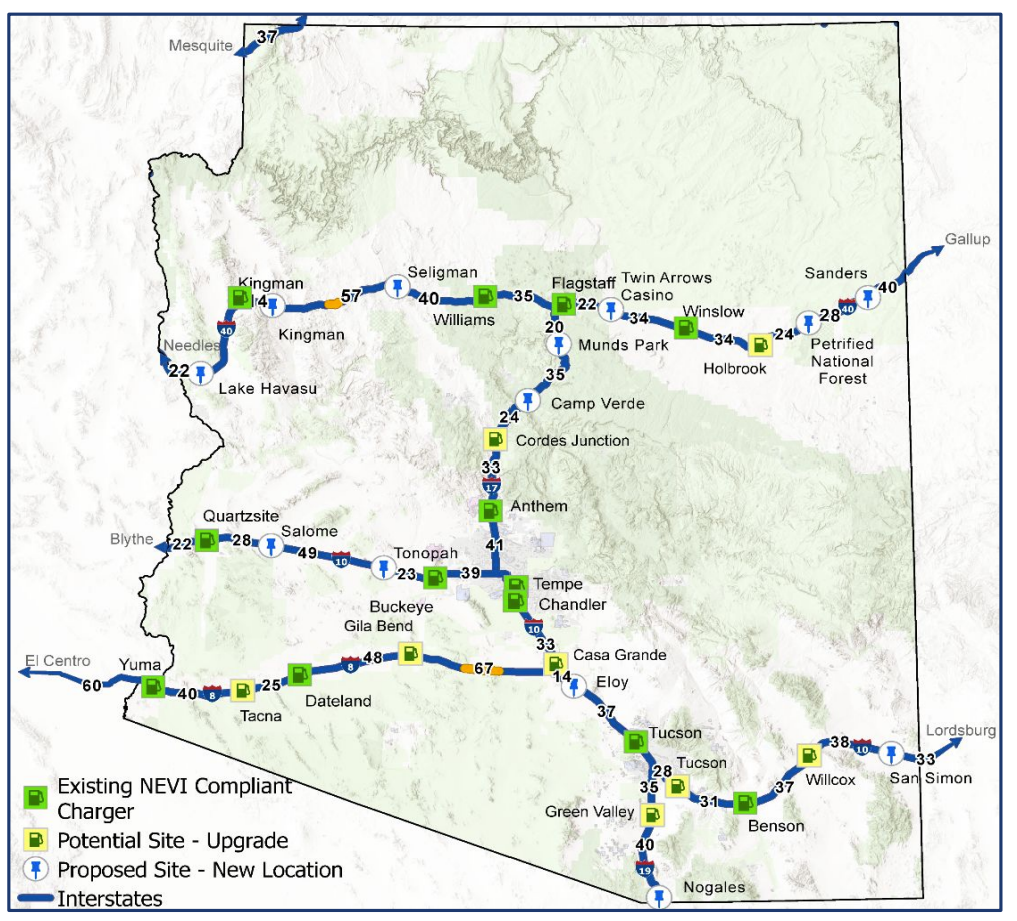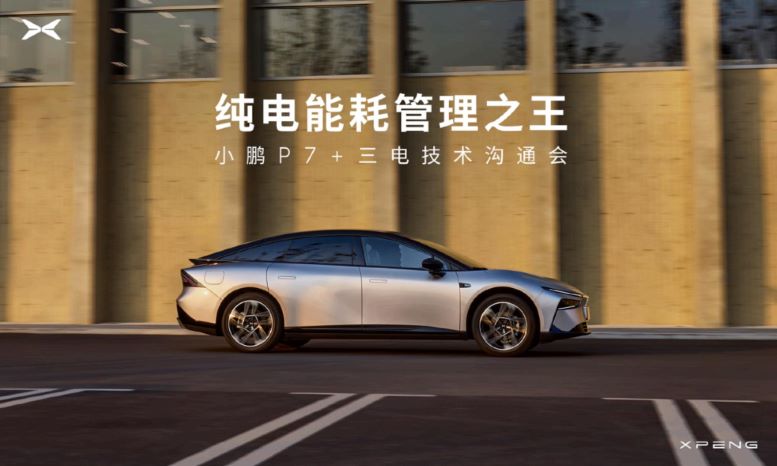Sign up for daily news updates from CleanTechnica on email. Or follow us on Google News!
In a recent public hearing, the Arizona Department of Transportation briefly touched on many aspects of the state’s EV charging plan. Specifically, ADOT got into how its staff plans to implement the NEVI program, which comes from the Infrastructure Bill (aka “Bipartisan Infrastructure Law, BIL, etc).
About The Program
As we’ve covered before, this program has several requirements that come from both the federal government and Arizona DOT. The feds require:
- Stations every 50 miles along alternative fuel corridors, starting with interstates
- At least four stalls per station
- 150 kW power minimum
- CCS connectors (NACS can be done in addition to CCS)
Arizona’s plan asked the federal government for two exceptions to the 50-mile rule, one on Interstate 40 and one on Interstate 8. These locations had a gap without a place to reasonably locate a station, so it makes sense to have a slightly longer gap in those places as few EVs wouldn’t be able to get through those gaps.
Where The Agency’s Looking For Site Hosts
At the end of the process, Arizona identified a number of rough locations where the state wants to use the federal funding for EV charging stations. Rather than list them all, I’ll put ADOT’s map for readers to look at:

If you own a business at any of the locations shown on the map (at yellow or white markers, as the green ones already have chargers), ADOT is looking for businesses to host the new EV chargers. Preferably, businesses hosting an EV charging station should be open either late or 24/7, have restrooms available, and have amenities drivers can use while their car charges (this usually takes from 15-45 minutes).
If you’re interested, you’ll want to submit your business information at this form. Once submitted and reviewed, your information will be put into a directory of businesses of all kinds willing to participate in the buildout of NEVI charging stations in Arizona.
What Happens Next
It’s important to note that Arizona DOT will not be choosing the sites directly. Once you’re in the directory, contractors interested in building stations will have access to your contact information and other information you submitted to the directory. These contractors will then submit bids to ADOT. If one of them wants to submit a bid for EV chargers at your site, they’ll turn that final bid information in.
Once bids are in, ADOT will then select the final winning sites. This involves a lot more than just the site, as the bids will have a lot of other information for DOT to consider. It’s possible that a great site with a bad proposal for chargers would lose to a not-as-good site with a better overall charging plan (not to mention coming in at a lower cost).
Other Highways Will Come Later, & You Can Submit Your Information For Those
If your business isn’t located on one those highways, there’s still a chance your business could be chosen in following years. After the state is done with its interstate highways, it will focus on other corridors.

For the highways in red, ADOT already has some locations in mind. If your business is located at one of the spots identified, you’ll definitely want to submit your information. If you’re along those highways, you may still want to contact ADOT and submit information in case the plan changes.
For the blue highways (the ones that will be done last), you’ll probably want to go ahead and submit information if your business is located anywhere on the highway. ADOT doesn’t have sites picked out along those roads, and your suggestion might still influence those decisions later. So, definitely put your information in.
What If My Business Isn’t Along Those Highways?
Arizona DOT’s NEVI program is only for one source of federal funding for EV charging stations. If you’re located in other communities around Arizona (or anywhere else for that matter), you’ll need to come up with funds for EV charging another way. This may actually be a good thing, because you’ll get more flexibility and choices in how you want to get charging at your business.
The topic of what other funding sources are available is too much for this article, but I know that there are grants, tax credits, and other money available. It’s also possible to partner with a private charging provider in many cases, or to take out loans for EV charging.
As a side hustle, I actually help rural businesses get EV charging going. If you’d like my help getting this sorted out, you can check out my website for this here.
What About NACS????
One thing I noticed during Arizona’s hearing is that a lot of people are still asking about NEVI and NACS. The goal of the recent hearing was to cover pricing at chargers, but as often happens, the commentary and Q&A went way off into left field. This is OK, as ADOT wants to hear everyone’s thoughts, but it can get a little tedious watching them answer the same questions about charging plugs over and over and over.
So, before you comment below about NACS or give ADOT an angry phone call, I want to briefly close this article discussing NACS again.
The sad truth (at least from a Tesla fan/stan perspective) is that it’s too late in the process for the federal government and Arizona (or any state government) to change course and make all of the new stations NACS-only. When the law was originally passed, CCS1 was the only standard connector that worked with all EVs. That has since changed, but the CCS standard is still the only one that meets the requirements of the Infrastructure Bill and subsequent federal rulemaking.
The good news is that states aren’t prohibiting the use of NACS, and some are even requiring proposals to include a second cable at each stall with a NACS plug on the end. In Arizona, bidders can definitely propose including NACS charging in some fashion, either as an additional station or as additional cables on stations. I’d imagine with the need for revenue from drivers that most if not all proposals will include NACS in some fashion.
It’s also worth noting that Tesla is almost guaranteed to win at several of the yellow sites on the map. Why? Because a Supercharger is already at an identified “upgrade” location, and Tesla can easily submit a bid for Magic Dock charging that nobody else will be able to beat with a new station. So, a chunk of the money is definitely going into Tesla’s pockets before this is over.
On top of that, Tesla is welcome to bid like anybody, and we’ve seen the company win in other states. The company could easily propose to install a new Supercharger with Magic Dock at any of the ADOT-identified locations, and Tesla’s pretty good at cost-effective and efficient station building. So, Tesla could easily end up winning a lot of money to expand the Supercharger network in the coming years from this program.
In other words, Tesla’s biggest, most obsessed fans should be happy about this program, as it’s going to be great for their favorite EV company.
Featured image: a screenshot from ADOT’s EV website showing some of the locations ADOT’s looking for locations for bidders to partner with.
Have a tip for CleanTechnica? Want to advertise? Want to suggest a guest for our CleanTech Talk podcast? Contact us here.
EV Obsession Daily!
I don’t like paywalls. You don’t like paywalls. Who likes paywalls? Here at CleanTechnica, we implemented a limited paywall for a while, but it always felt wrong — and it was always tough to decide what we should put behind there. In theory, your most exclusive and best content goes behind a paywall. But then fewer people read it!! So, we’ve decided to completely nix paywalls here at CleanTechnica. But…
Thank you!
Tesla Sales in 2023, 2024, and 2030
CleanTechnica uses affiliate links. See our policy here.





